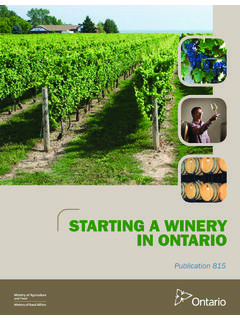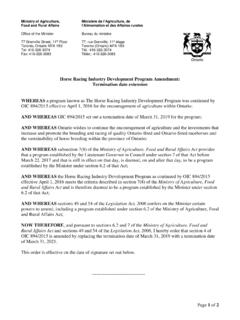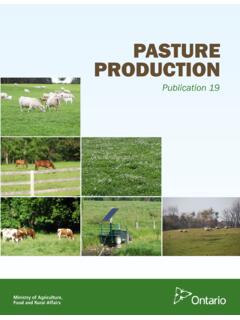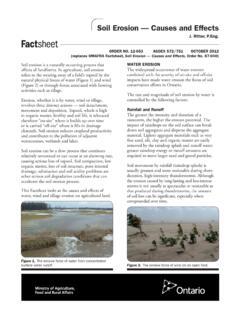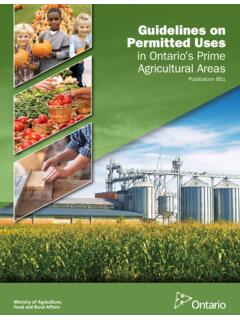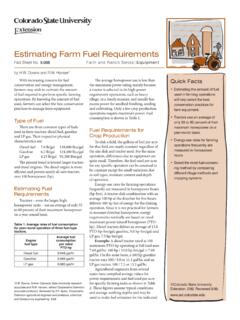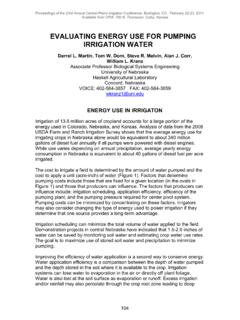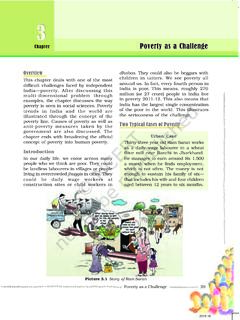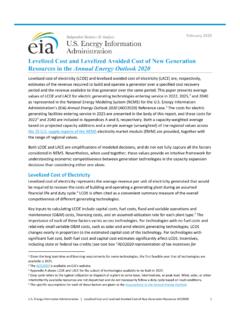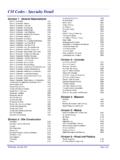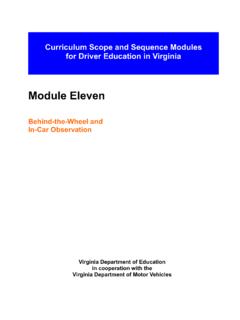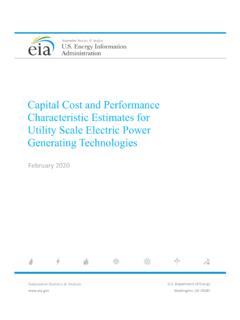Transcription of Publication 60 Field Crop Budgets
1 2018 Field CROP BUDGETSP ublication 601. Alfalfa-Timothy Hay2. Barley3. Spring Canola4. Winter Canola5. Coloured Beans6. Grain Corn7. Silage Corn8. Flax9. Oats10. Soybeans11. Switchgrass12. Soft Red Winter Wheat13. Hard Red Winter Wheat14. Hard Red Spring Wheat15. White/Black Beans16. Organic Grain Corn and Soybeans17. Organic Winter Wheat and Spelt18. Organic Barley and OatsThese crop Budgets are a tool for estimating expenses. The sample costs are only a guide to illustrate a method of preparing your projections. They are based on many assumptions, including seeding rates, levels of fertilizer use, etc. Due to regional differences, there may be considerable variation in project your break-even price after total costs, enter your farm figures in the spaces provided.
2 The resulting estimate will help you choose your crop mix and set target prices and marketing strategies for your versions of these crop budget worksheets can be found at under Cost of Production use of imperial and metric measurement in this Publication reflects the way information is reported by industry. Seeding rates are typically reported in pounds (lb)/acre, and fertilizer rates are reported in kilogram (kg)/hectare. See page 20 for metric and imperial Field Crop Budgets2018 Field Crop Budgets2018 Field CROP BUDGETSCrop Budgets are a management tool to estimate costs and evaluate cropping alternatives. The sample costs are not averages or recommended treatments.
3 The Budgets comprise treatments derived from crop advisors in the areas where the crops are commonly grown. There will be differences due to growing region, cropping practices, individual needs and yield expectations. The Budgets , unless indicated otherwise, are based on conventional tillage practices. Seed costs, except for the Bacillus thuringiensis (Bt), Roundup Ready (RR) and herbicide-tolerant corn, spring canola and soybeans, are for non-genetically enhanced varieties. The Budgets developed for Bt, RR or herbicide-tolerant varieties do not represent an endorsement of these products. They are included due to the current predominance of these production systems in Field crop Preserved (IP) crops require budgeting for any extra expenses and revenue, , increased seed, weed control, storage and equipment cleaning costs.
4 Some of the Budgets provide a line item for rates were calculated at for the period between planting and Budgets will be most meaningful if you use your expected yields and specific costs in developing production plans. Input prices for seed, fertilizer, fuel and pesticides were based on the survey results reported in the Ontario farm Input Monitoring Project conducted by the University of Guelph, Ridgetown campus. The production insurance premiums shown are the producer premiums at the highest coverage level and at the floating price, if estimated costs for machinery are derived from agricultural engineering formulas and Ontario average custom rates. The Ontario average custom rates are allocated across the six machinery-related expenses.
5 It is recommended that you use your records to derive your costs. Experience is the best guide to help budget machinery costs. Prior year s statements of income and expenses can provide information on equipment repairs, maintenance and fuel costs. The portion of those costs that relates to crop production can be divided by the acres of crop produced to arrive at a cost per expenses are a major part of the total cost of doing business. In addition to the depreciation of machinery, include depreciation on all related tools and storage buildings. Land costs would include property tax and any other land-related costs. Other overhead expenses should include insurance, professional fees, office, vehicles and storage.
6 In all cases, divide overhead expenses by the acreage of crop to express costs on a per-acre basis. Interest on investment is an opportunity cost to you the rate of return that you expect or want on your invested there are significant debt commitments for land and equipment, an alternative method of budgeting overhead expenses is to use the debt servicing requirements. In this case, use the actual interest and principal payment commitments, rather than depreciation and expected return on invested capital. Total Revenue is the yield you expect multiplied by the price you expect. Yield information is most accurate if based on your experience with the land and techniques you will be using.
7 If you do not have such records, check with AGRICORP or a local farm supply dealer. They can help you develop plans and reasonable expectations for your crops. Gross Margin is the difference between total operating expenses and total revenue. Operating Expenses ( , seed, fertilizer, fuel , repairs, etc.) change with the crop grown and the production blend used. Fixed or overhead costs will show little or no change whether one crop or another is grown. Gross Margin is a quick and easy measure for comparing relative profitability among your cropping 1. Adjustment of nitrogen requirements for previous crops with nitrogen creditsType of cropN requirement reduction (kg/ha)CornOther CropsPerennial forage, less than one-third legume00 Perennial forage, one-third to half legume5555 Perennial forage, half or more legume110110 Clover cover crop seeded/ploughed in same year80451 Soybean and Field bean residue3001 Applies where the legume stand is thick and over 40 cm (16 in.)
8 Field Crop Budgets2018 Crop Comparison Summary Table for Selected Field Crops ($/acre)*ExpenseCorn Conventional TillageHerbicide- Tolerant Spring CanolaNon-GMOS oybeans No TillRoundup Ready Soybeans No TillColoured BeansWhite/ Black BeansSoft Red Winter Wheat No TillOats (Southern Ontario)Hard Red Spring & Production @ & Price Gross Return Net Margin/Acre Less: Land cost/rent Utilities/acct/misc. Net Return per Acre * The crop comparison summary table is derived from the individual Budgets in the Publication . Some expense items have been combined in the summary table. For the break-out of the individual expenses, refer to the respective budget in the for the 2018 Field Crop BudgetsRisk Management Program premiums have been added.
9 Premiums shown are the producer premiums at the highest coverage : Minimum wage increased from $ in 2017 to $ by January 2018. Many farms already pay farm machinery operators above minimum wage; it was assumed that there would likely be an increase in wages to employees being paid above this level as well. For the 2018 Budgets , the machinery operator rate was increased $ per hour to $ Budgeting Tools: Ontario Enterprise Budgeting Tools: , search for budgeting tools Custom Farmwork Rates: , search for custom farm rates Custom Farmwork Rate calculator: , search for custom farm rate calculator Crop Nutrient Removal calculator (from IPNI): Corn Nitrogen calculator: Mobile Apps: Cash Cropper, Pest Manager and Ontario Corn Nitrogen Calculator.
10 Field Crop BudgetsALFALFA-TIMOTHY HAYDIRECT SEEDING ESTABLISHMENTS ample Costs/AcreYour farm BudgetSeed12 lb/acre Other seed (timothy)4 Fertilitycrop removal23 kg/ha P2O5 ( kg/tonne removal rate) 92 kg/ha K2O ( kg/tonne removal rate) Herbicidebroadleaf weed Production Tractor and machine expensesfuel (27 L) and Custom work2 pesticide 2 fertilizer applications, mixing and bale wrapping plastic 50% Twine Operator labour (self or hired) Interest Total Establishment Year ANNUAL OPERATING EXPENSES (costs based on projected yield of tonnes DM/acre)Establishment year expenses over 4 years (less establishment year sales) Fertilitycrop removal46 kg/ha P2O5 ( kg/tonne removal rate) 185 kg/ha K2O (applied in fall) ( kg/tonne removal rate) Tractor and machine expensesfuel (17 L) and Production Custom work2 fertilizer applications, mixing and bale wrapping Other costs Land rent Operator labour (self or hired) Interest on Total Annual Operating REVENUEE xpected yield _____ Expected price _____ Total Revenue (Yield x Price) GROSS MARGIN (Revenue Operating Expenses) OVERHEAD interest on Land Other NITROGEN CREDIT TO FOLLOWING CROPS IN ROTATIONN itrogen credit ($/acre = N reduction (from Table 1) x price of N)
